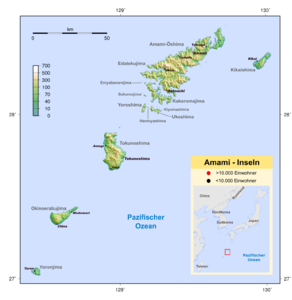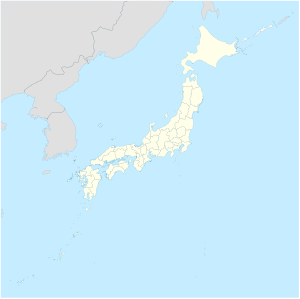Amami Islands
| Amami Islands | ||
|---|---|---|
| Map of the Amami Islands | ||
| Waters | East China Sea | |
| archipelago | Satsunan Islands | |
| Geographical location | 27 ° 50 ' N , 129 ° 0' E | |
|
|
||
| Number of islands | 13 | |
| Main island | Amami-Ōshima | |
| Total land area | 1,231.47 km² | |
| Residents | 105,066 (October 1, 2019) | |
The Amami Islands ( Japanese 奄 美 群島 , Amami-guntō , also 奄 美 諸島 , Amami-shotō ) are part of the Ryūkyū Islands or the Nansei Islands which have existed as a political region since 1970.
geography
The Amami Islands lie between the Tokara Islands and the Okinawa Islands .
In detail, the following islands belong to the archipelago, with the exception of smaller rocks:
| Surname | Japanese | Communities | Residents | Area [km²] |
|---|---|---|---|---|
| Amami-Ōshima | 奄 美 大 島 | Amami , Setouchi , Tatsugō , Uken , Yamato | 73,000 | 504.88 |
| Edatekujima | 枝 手 久 島 | ? (uninhabited) | ||
| Kikaijima / Kikaigashima | 喜 界 島 | Kikai | 7,657 | 56.93 |
| Kakeromajima | 加 計 呂 麻 島 | Setouchi | 1,600 | 77.39 |
| Eniyabanarejima | 江 仁 屋 離島 | ? (uninhabited) | ||
| Sukomojima ? | 須子 茂 島 | ? (uninhabited) | ||
| Yorojima | 与 路 島 | Setouchi | 140 | 9.35 |
| Ukejima | 請 島 | Setouchi | 200 | 13.35 |
| Kiyamashima ? | 木 山 島 | ? (uninhabited) | ||
| Hanmyashima | ハ ン ミ ャ 島 | ? (uninhabited) | ||
| Tokunoshima | 徳 之 島 | Amagi , Isen , Tokunoshima | 27,000 | 247.77 |
| Okinoerabujima | 沖 永良 部 島 | Wadomari , Wana | 15,000 | 93.63 |
| Yoronjima | 与 論 島 | Yoron | 98 | 20.80 |
history
From 1945 to 1953 the archipelago was under American occupation .
language
The Amami dialect spoken by the residents is one of the Ryūkyū languages .
Flora and fauna
The amami rabbit ( Pentalagus furnessi ) and the amami woodcock ( Scolopax mira ) are endemic species of the archipelago . As of March 7, 2017, 42,181 hectares of the islands and 33,082 hectares of the marine area were assigned to the newly established Amamiguntō National Park .
Personalities
- Tajima Nabi (1900–2018), age record holder
Web links
Individual evidence
- ↑ Kokudo Chiriin , February 19, 2010: 『奄 美 群島』 を 決定 地名 に 採用 ( archived page in the Internet Archive )
- ↑ Ajiro Tatsuhiko and Warita Ikuo, Waga kuni no kōiki na chimei oyobi sono han'i ni tsuite no chōsa kenkyū (The geographical names and those extents of the wide areas in Japan), Kaiyō Jōhōbu Gihō, Vol. 27, 2009.
- ^ Robert D. Eldridge: The Return of the Amami Islands: The Reversion Movement and US-Japan Relations . Lexington Books, 2004, ISBN 978-0739107102 .

